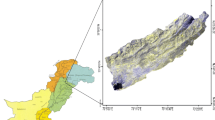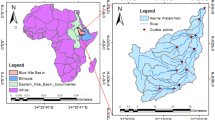Abstract
Specific degradation (SD) is defined as the ratio of the sediment yield divided by the watershed area to compare sediment yield at the basin scale. The SD from 35 watersheds was calculated from field measurements of discharge and sediment concentrations. The watershed characteristics for each watershed were analyzed using GIS tools. All sediment gauging stations are located in alluvial river reaches and the estimated specific degradation typically ranges between 100 and 1,000 tons/km2·yr. Six regression models based on the watershed characteristics are proposed to estimate the mean annual sediment yield. The most useful relationship is function of the drainage area and mean annual precipitation. The proposed models were tested and validated with 15 additional river stations. The root mean square errors (RMSE) of the predictions are approximately 100 tons/km2·yr which is found to be satisfactory. The proposed models should be useful to estimate the sediment yield from ungauged watershed in South Korea.
Similar content being viewed by others
References
Einstein, H. A. (1950). The bed-load function for sediment transportation in open channel flows, U.S. Department of Agriculture, Washington, DC, USA.
Faran Ali, K. and De Boer, D. H. (2008). “Factors controlling specific sediment yield in the upper Indus River basin, Northern Pakistan.” Hydrological Processes, Vol. 22, No. 16, pp. 3102–3114, DOI: https://doi.org/10.1002/hyp.6896.
Flaxman, E. M. (1972). “Predicting sediment yield in western USA.” Journal of the Hydraulics Division, Vol. 98, No. 12, pp. 2073–2085.
Fournier, F. (1960). Climat et érosion”: la relation entre l’érosion du sol par l’eau et les précipitations atmosphériques, Presses universitaires de France, Paris, France.
Haregeweyn, N., Poesen, J., Nyssen, J., Verstraeten, G., de Vente, J., Govers, G., Deckers, S., and Moeyersons, J. (2005). “Specific sediment yield in Tigray-Northern Ethiopia: Assessment and semi-quantitative modelling.” Geomorphology, Vol. 69, Nos. 1–4, pp. 315–331, DOI: https://doi.org/10.1016/j.geomorph.2005.02.001.
Ichim, I. (1990). “The relationship between sediment delivery ratio and stream order: A Romanian case study.” IAHS Publication, No. 189, pp. 79–86.
Jansen, I. M. L. and Painter, R. B. (1974). “Predicting sediment yield from climate and topography.” Journal of Hydrology, Vol. 21, No. 4, pp. 371–380, DOI: https://doi.org/10.1016/S0022-1694(74)80006-5.
Julien, P. Y. (2002). River mechanics, Cambridge University Press, Cambridge, UK.
Kane, B. and Julien, P. (2007). “Specific degradation of watersheds.” International Journal of Sediment Research, Vol. 22, No. 2, pp. 114–119.
Kane, B. and Julien, P. Y. (2003). Specific degradation as function of watershed characteristics and climatic parameters, PhD Thesis, Colorado State University, Fort Collins, CO, USA.
Langbein, W. B. and Schumm, S. A. (1958). “Yield of sediment in relation to mean annual precipitation.” EOS, Transactions, American Geophysical Union, Vol. 39, No. 6, pp. 1076–1084, DOI: https://doi.org/10.1029/tr039i006p01076.
Lee, Y. K., Go, J. Y., Lee, J. W., and Jung, S. W. (2009). “Development of sediment discharge computation system for characteristic analysis of river sediment discharge.” Proceedings of the Korea Water Resources Association Conference, pp.723-727.
Merritt, W. S., Letcher, R. A., and Jakeman, A. J. (2003). “A review of erosion and sediment transport models.” Environmental Modelling and Software, Vol. 18, Nos. 8–9, pp. 761–799, DOI: https://doi.org/10.1016/S1364-8152(03)00078-1.
MOC (1992). Research of specific sediment yield in watershed for dam design, Ministry of Construction, Korea.
MOLTMA (1992). Dam design manual and analysis, Ministry of Land, Transport and Maritime Affairs, Korea.
Rouse, H. (1937). “Modern conceptions of the mechanics of fluid turbulence.” Trans ASCE, Vol. 102, pp. 463–505.
Sahaar, A. S., Syvitski, J. P. M., Peckham, S. D., Hilberman, R., and Mulder, T. (2003). “Predicting the terrestrial flux of sediment to the global ocean: A planetary perspective.” Sedimentary Geology, Vol. 162, Nos. 1–2, pp. 5–24, DOI: https://doi.org/10.1016/S0037-0738(03)00232-X.
Strahler, A. N. (1952). “Hypsometric (area-altitude curve) analysis of erosional topography.” Bulletin of the Geological Society of America, Vol. 63, No. 11, pp. 1117–1141, DOI: https://doi.org/10.1130/00167606(1952)63[1117:HAAOET]2.0.CO;2.
Vanmaercke, M., Poesen, J., Broeckx, J., Nyssen, J. (2014). “Sediment yield in Africa.” Earth-Science Reviews, Vol, 136, pp. 350–368.
Vente, J., Verduyn, R., Verstraeten, G., Vanmaercke, M., and Poesen, J. (2011). “Factors controlling sediment yield at the catchment scale in NW Mediterranean geoecosystems.” Journal of Soils and Sediments, Vol. 11, No. 4, pp. 690–707, DOI: https://doi.org/10.1007/s11368-0110346-3.
Wheater, H. S., Jakeman, A. J., and Beven, K. J. (1993). “Progress and directions in rainfall-runoff modelling.” Modelling change in environmental systems, Wiley, Chichester, pp. 101–1322.
Yoon, B. and Woo, H. (2000). “Sediment problems in Korea.” Journal of Hydraulic Engineering, Vol. 126, No. 7, pp. 486–491, DOI: https://doi.org/10.1061/(asce)0733-9429(2000)126:7(486).
Yoon, Y. N. (1981). “Estimation of silting load and capacity loss rate of irrigation revervoirs.” Journal of the Korean Society of Civil Engineers, Vol. 1, No. 1, pp. 69–76.
You, S. C. and Min, B. H. (1975). “A study for sedimentation in reservoir -on district of Chin Young.” Journal of the Korean Society of Agricultural Engineers, Vol. 17, No. 3, pp. 46–53.
Acknowledgements
This work is supported by the Korea Agency for Infrastructure Technology Advancement (KAIA) grant funded by the Ministry of Land, Infra structure and Transport (Grant 19AWMP-B121100-04).
Author information
Authors and Affiliations
Corresponding author
Rights and permissions
About this article
Cite this article
Kang, W., Yang, CY., Lee, J. et al. Sediment Yield for Ungauged Watersheds in South Korea. KSCE J Civ Eng 23, 5109–5120 (2019). https://doi.org/10.1007/s12205-019-0085-3
Received:
Revised:
Accepted:
Published:
Issue Date:
DOI: https://doi.org/10.1007/s12205-019-0085-3




